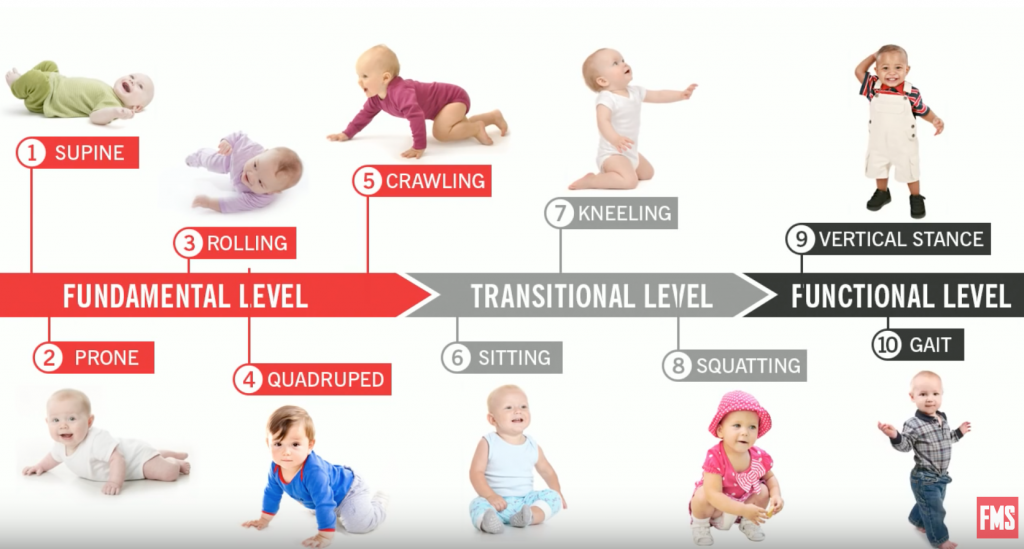The movements that most people lose their ability to perform as they age (toe touch, squat, getting down onto and up off of the floor) are the movements that develop during the first year of life. These movements are hard-wired into our nervous system.
Functional movements involve multiple joints and are used to help us to transition from one position to another. The squat is a natural rest position utilized more frequently in countries that have much lower occurrences of low back pain. The hip hinge pattern demonstrated in the deadlift is the natural way to pick an object off of the floor. A split stance position like the lunge involves lowering one knee to the floor to change levels.
The ability to maintain competency in performing these movements is what helps someone maintain flexibility, engage in sports, and properly stabilize their spine for activities of daily living.
Dynamic Neuromuscular Stabilization (DNS) is an approach to rehabilitation that uses these developmental positions to restore proper joint alignment, stability, and motor control of the extremities.
You have to learn how to crawl before you can walk. The developing child learns to integrate spinal stabilization with movement of the extremities beginning at the age of three months. These developmental positions form the basis for the functional movement patterns that transfer into activities of daily living and more complex athletic movements.

DNS is a unique approach to troubleshooting a particular movement pattern because of its understanding of what should occur at each segment of the body at a given time. This provides a superior assessment framework for analyzing movement with the advantage that the corrective strategy can be tailored to someone’s current movement capability.

A movement like the golf swing can be trained at the developmental level that matches someone’s proficiency in core stabilization, range of motion, and joint alignment. This allows for exercise regressions that simplify the desired movement before progressing the movement into a more complex upright pattern with the same principles of alignment and stabilization.
Regardless of the degree of difficulty of the prescribed exercise – the position that is trained is far superior to commonly used isolation exercises that often fail to integrate muscle activation into the more complex movement patterns that sports and activities like running require.
Dynamic Neuromuscular Stabilization Benefits
- Superior to commonly prescribed isolation exercises
- Enhances control of multiple joints at the same time
- Integrated abdominal co-activation
- Normalizes breathing and diaphragm function
- Improves posture and normal joint alignment
- All exercises correlate to functional movement patterns
- One position/exercise can correct multiple dysfunctions
- Resets the central nervous system
Using a Developmental Approach to Improve Flexibility
We can use the developmental positions as a relevant basis of comparison between how someone moves and how they actually should move based on expected movement metrics.
One of the primary benefits of yoga is the stabilization that is required for transitional movements. However, the metrics used in yoga are often specific to being able to do the yoga poses themselves – some of which do not translate into functional activities of daily living.
Some yoga poses actually encourage overstretching of muscles and ligaments – because the stabilization requirements of many positions are overlooked in a misguided attempt to merely increase flexibility in extreme ranges. Another example is gymnasts who are able to do the splits but are limited in other movements – like the squat and toe touch. It is important to have an appropriate frame of reference in regard to what movements should be used to increase flexibility in an appropriate and relevant way.
By using a framework of developmental kinesiology, we can ensure that gains in range of motion do not come at the expense of overstretching muscles and supporting ligaments. Many tight individuals that regularly stretch – experience chronic tightness – because they are over-relying on passive joint stability. By increasing flexibility in positions that encourage active stabilization of multiple joints we can prevent overstretching and achieve permanent gains in range of motion.
By utilizing these developmental positions and movement transitions – magic happens. You will regain your ability not just to run, squat, and perform athletic movements – but to move our body in a pain-free youthful manner. What these developmental positions all have in common is core stabilization, proper joint alignment, and integrated breathing patterns.